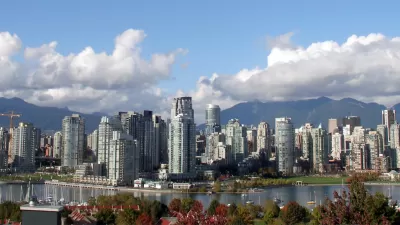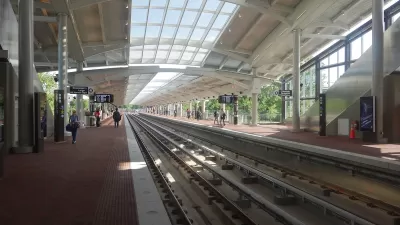WROCLAW, Poland--I have been swanning about Eastern Europe for the better part of two months, wandering the streets of cities large and small, famous and obscure. As should be apparent to anyone short of Toby Keith or James Inhofe, even the most undistinguished European city could teach any American city a thing or two about charm, walkability, and gracious living.
WROCLAW, Poland--I have been swanning about Eastern Europe for the better part of two months, wandering the streets of cities large and small, famous and obscure. As should be apparent to anyone short of Toby Keith or James Inhofe, even the most undistinguished European city could teach any American city a thing or two about charm, walkability, and gracious living.
At the same time, I have come to bemoan American cities a little less intensely than I used to.
Though the likes of Paris, Rome, Prague, and Florence rightfully beckon tourist masses who come to enjoy the one thing that American capitalism can't buy, the amazing thing about Europe is that those cities are not exceptional, in the strictest sense of the world, but rather merely the best examples of a class of city that dominates the urban landscape from Lisbon to Kiev.
Plotted according to whimsy, necessity, and expediency (not zoning) largely before the conquest of the Americas and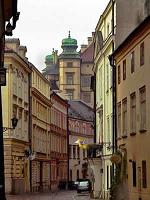 rebuilt countless times with only slight alternations, European cities thrive on density, irregular streets, plazas, squares, parks, and miles of architecture that all looks Baroque to me. Sidewalks as wide as basketball courts line the streets, and beer flows freely in outdoor cafes. Streetcars and subways tie it all together, and the relatively few cars must often inch along cobbles and share pavement with pedestrians. Cities you have never heard of have streets that put some our most beloved thoroughfares to shame. This pattern appears with such astounding ubiquity that, indeed, it approaches tedium.
rebuilt countless times with only slight alternations, European cities thrive on density, irregular streets, plazas, squares, parks, and miles of architecture that all looks Baroque to me. Sidewalks as wide as basketball courts line the streets, and beer flows freely in outdoor cafes. Streetcars and subways tie it all together, and the relatively few cars must often inch along cobbles and share pavement with pedestrians. Cities you have never heard of have streets that put some our most beloved thoroughfares to shame. This pattern appears with such astounding ubiquity that, indeed, it approaches tedium.
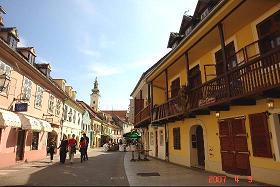 Forget about the typical dullards: Indianapolis, Atlanta, Charlotte, Fresno, or any other of the dozens of sprawl-fests that we call home. If you put the best American cities up against the most random of Eastern European rivals--they don't even have to be capitals or centers of culture--and Budapest, Krakow, Olomouc, and even Bratislava (yes, Bratislava) will have them beat. Excluding San Francisco and New York (and Boston on a good day), no American city has a street or neighborhood with as much charm as any of the historic cores of the Old World. I will never understand why an entire generation of planners ignored these virtues. (Granted, emulating Europe was probably not in vogue in the wake of World War II, but to dismiss an entire continent for the sake of highways and cars seems an ironic way to assert national pride.)
Forget about the typical dullards: Indianapolis, Atlanta, Charlotte, Fresno, or any other of the dozens of sprawl-fests that we call home. If you put the best American cities up against the most random of Eastern European rivals--they don't even have to be capitals or centers of culture--and Budapest, Krakow, Olomouc, and even Bratislava (yes, Bratislava) will have them beat. Excluding San Francisco and New York (and Boston on a good day), no American city has a street or neighborhood with as much charm as any of the historic cores of the Old World. I will never understand why an entire generation of planners ignored these virtues. (Granted, emulating Europe was probably not in vogue in the wake of World War II, but to dismiss an entire continent for the sake of highways and cars seems an ironic way to assert national pride.)
Of course, sprawl is advancing on Europe too. Suburban developments, office parks, and big boxes are well on the march, but at least they surround something worth visiting. Indeed, perhaps Europe is adopting a more American form because they are tired of the close quarters and the weight of history. For them, spectacular town squares and cozy, well kempt alleyways are simply nothing new.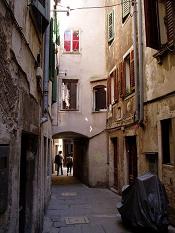 But sheer boredom may not be the only reason why European cities are fleeing to their own suburbs and edge cities. Restlessness and expansion are understandable when, after several centuries of development, urban cores have become built out in ways that provide the settings for the worst nightmares of American developers and planners. In most city centers, you can go an entire block without being able to slip so much as a sheet of paper between buildings. Five- and six-flight staircases lead up from sidewalk cafes to attic apartments, and streets the width of hallways separate odd from even addresses. I often wonder who owns those buildings. They must have
But sheer boredom may not be the only reason why European cities are fleeing to their own suburbs and edge cities. Restlessness and expansion are understandable when, after several centuries of development, urban cores have become built out in ways that provide the settings for the worst nightmares of American developers and planners. In most city centers, you can go an entire block without being able to slip so much as a sheet of paper between buildings. Five- and six-flight staircases lead up from sidewalk cafes to attic apartments, and streets the width of hallways separate odd from even addresses. I often wonder who owns those buildings. They must have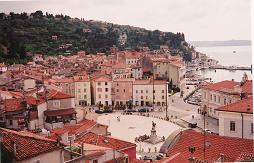 been passed down from countless generations, or maybe the state owns them. In any event, the people at the front of the unemployment line are probably the urban infill developers. There's hardly room to add a coat of paint, much less a new building.
been passed down from countless generations, or maybe the state owns them. In any event, the people at the front of the unemployment line are probably the urban infill developers. There's hardly room to add a coat of paint, much less a new building.
Europe is, in short, done.
America should kick itself for deviating so far from the European model and creating cities and suburbs whose flaws are so well documented that I need not belabor them herein. Yet while Europe stagnates, every vacant lot, parking lot, and crumbling industrial site in America's own urban cores gives America the opportunity to do what it does best: innovate and build. Indeed, the problem with perfection is that there's nothing to improve on.
Notwithstanding the staggering human toll that accompanied Manifest Destiny (i.e. genocide, ethnic cleansing, theft of land) , the crowing achievement of the American people is the conquest of vacancy. This process was unique to American and, indeed, helped create the very notion of Americans as a nation. But now that the highways run from coast to coast and every piece of land, godforsaken and otherwise, has been bought and somehow developed--as homestead, office park, golf course, or whatever else has struck our fancy--opportunities to build, and evolve, persist even as we press up against the boundaries of the continent.
While Old Town Krakow quivers under the feet of countless tourists, Downtown, USA, remains, relatively speaking, as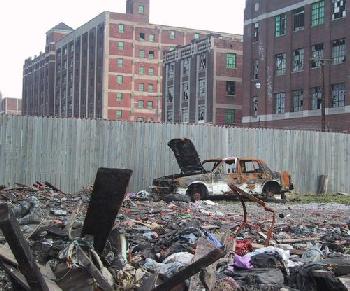 open as the frontier, with parking lots the size of prairies. Since America finally seems to be coming around to the characteristics that typify pleasant, vibrant cities, the time has come for the next steps: we must figure out what those characteristics look like, and we must figure out where to put them.
open as the frontier, with parking lots the size of prairies. Since America finally seems to be coming around to the characteristics that typify pleasant, vibrant cities, the time has come for the next steps: we must figure out what those characteristics look like, and we must figure out where to put them.
The first task falls to the usual suspects--architects, developers, and civic folks--and we can only hope that some pleasing combination of high art and new vernacular will emerge, ideally with variations from city to city. For the second task, the choices are obvious. American cities may not have dense, charming downtowns now, but in 50 years we could. They will not look like the cities that I've been travelling in, and nor should they. They should reflect new conceptions of fashion and form and they should be innovative, according to considerations such as the environment, diversity, and all the other trappings of the postmodern lifestyle. The last thing we want is a facsimile of the old.
Some serious dreaming must now ensue, and action must follow it. For every European sophisticate who sips coffee amid Prague's or Vienna's or Wroclaw's throng, American planners and urbanists must make lonely reconnaissance missions to weedy lots, blank streetfronts, and abandoned buildings and imagine what they might become. That is, I'm certain, the only way the pioneers found solace when they drove the first stakes into hard country, and even as many of us yearn for the Old World, America must do the same once again.

Maui's Vacation Rental Debate Turns Ugly
Verbal attacks, misinformation campaigns and fistfights plague a high-stakes debate to convert thousands of vacation rentals into long-term housing.

Planetizen Federal Action Tracker
A weekly monitor of how Trump’s orders and actions are impacting planners and planning in America.

San Francisco Suspends Traffic Calming Amidst Record Deaths
Citing “a challenging fiscal landscape,” the city will cease the program on the heels of 42 traffic deaths, including 24 pedestrians.

Defunct Pittsburgh Power Plant to Become Residential Tower
A decommissioned steam heat plant will be redeveloped into almost 100 affordable housing units.

Trump Prompts Restructuring of Transportation Research Board in “Unprecedented Overreach”
The TRB has eliminated more than half of its committees including those focused on climate, equity, and cities.

Amtrak Rolls Out New Orleans to Alabama “Mardi Gras” Train
The new service will operate morning and evening departures between Mobile and New Orleans.
Urban Design for Planners 1: Software Tools
This six-course series explores essential urban design concepts using open source software and equips planners with the tools they need to participate fully in the urban design process.
Planning for Universal Design
Learn the tools for implementing Universal Design in planning regulations.
Heyer Gruel & Associates PA
JM Goldson LLC
Custer County Colorado
City of Camden Redevelopment Agency
City of Astoria
Transportation Research & Education Center (TREC) at Portland State University
Jefferson Parish Government
Camden Redevelopment Agency
City of Claremont



























